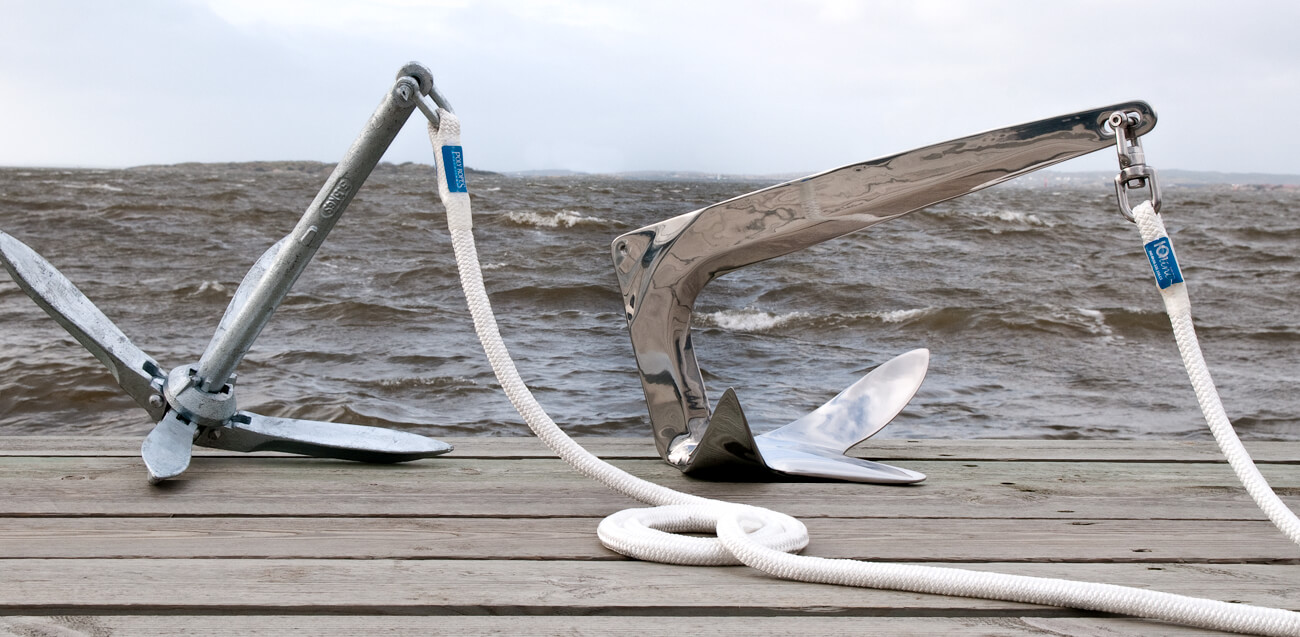Anchoring
Being able to anchor correctly in a safe manner provides you with more freedom and flexibility in your boat life. In natural harbors and guest harbors it is usually necessary to use an anchor when mooring. When anchoring it is important to keep in mind that it should never be used as a permanent mooring/docking solution. When anchoring the boat can never be left unattended.
It is important that you have a good idea of what the sea or lake bottom surrounding the boat looks like when anchoring. Detta för att försäkra dig om att botten kan ge ett bra ankarfäste. This is order to ensure that the bottom provides good holding ground. When anchoring the anchoring line or chain should also have significant length, 5 times the water depth is a good rule of thumb. Also remember to fasten the anchor line to the boat before submerging the anchor. It is also important to make sure the anchor line does not get caught in any propellers.
Anchoring Line
When anchoring you also need to enlighten other boat owners about your anchoring line so they do not run it over. Our Synsten anchor line is designed for just this purpose. The line has a bright orange color that is highly visible in water. It is also equipped with a chain for the last three meters at the anchor side so the line sinks and sets in a correct position. The chain is covered with a tubular woven casing made of 100% polyester silk in order to protect it against wear-and-tear as well as protect the boat from the chain chafing it.
How to anchor
1. Choose the right location: Before starting the anchoring process, it is important to choose a suitable anchoring location. Look for sheltered coves or bays that provide protection from winds and currents. Avoid areas with shallows or underwater obstacles.
2. Check the weather and conditions: Before anchoring, it is important to check the weather and water conditions. Keep track of wind strength and direction, currents and any changes that may affect the stability of the anchor.
3. Prepare the equipment: Check that your anchoring equipment is in good condition. Make sure the anchor is correctly sized for your boat and that the anchor line is strong and long enough to reach the bottom.
| Boat weight | Boat length | Anchor weight |
| 2.0 tonnes | 7,0 m | 5,0 kg |
| 3.5 tonnes | 9,0 m | 7,5 kg |
| 6.0 tonnes | 11,0 m | 10,0 kg |
| 10.0 tonnes | 12,5 m | 15,0 kg |
| 20.0 tonnes | 14,5 m | 20,0 kg |
4. Do a safety check: Before anchoring, make sure that everyone on board is aware of the anchoring procedure and that all safety measures have been taken. Ensure that all necessary safety equipment is available and that all passengers wear life jackets.
5. Walk slowly and methodically: as you approach the selected anchorage point, reduce your speed and move forward slowly. Communicate with everyone on board to ensure everyone is ready for anchoring.
6. Set the anchor: Once you have reached the desired position, lower the anchor and let the line run out a bit. Then make sure the anchor gets a good grip on the bottom by putting some tension on the line.
7. Check anchor grip: Give the boat time to react and check that the anchor is holding. If the anchor does not hold, repeat the anchoring process or consider changing the location.
8. Monitor the anchorage: Always keep an eye on the anchorage to make sure the boat is not drifting. Pay attention to any changes in wind or water conditions that may affect the anchorage.

